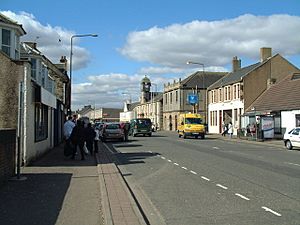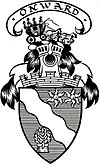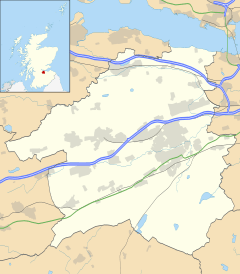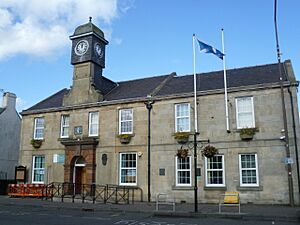Whitburn, West Lothian facts for kids
Quick facts for kids Whitburn
|
|
|---|---|
 Whitburn, looking west towards the town centre |
|
 Coat of arms of Whitburn Onward |
|
| Population | 11,490 (2020) |
| OS grid reference | NS945645 |
| Council area | |
| Lieutenancy area | |
| Country | Scotland |
| Sovereign state | United Kingdom |
| Post town | BATHGATE |
| Postcode district | EH47 |
| Dialling code | 01501 |
| Police | Lothian and Borders |
| Fire | Lothian and Borders |
| Ambulance | Scottish |
| EU Parliament | Scotland |
| UK Parliament |
|
| Scottish Parliament |
|
Whitburn (originally Whiteburn) is a small town in West Lothian, Scotland. It is located about 23 miles (37 km) east of Glasgow and 22 miles (35 km) west of Edinburgh. This means it's almost exactly halfway between Scotland's two biggest cities! The closest large towns are Bathgate, which is 4 miles (6 km) away, and Livingston, which is 6 miles (10 km) away.
Contents
History of Whitburn
Whitburn started as a small community focused on farming and weaving. It grew around a small stream, called a "burn". It used to be part of Linlithgow until 1973. Before 1730, it was a parish of Livingston. As more people moved there, Whitburn became its own parish.
The first reliable population count was in 1755, with 1,121 people. By 1795, the population had grown to 1,322.
Whitburn has been on maps since the 1600s. A Scottish map maker named John Adair included it on a map in 1680. The very first mention of Whitburn in official papers was on September 26, 1363. This was in a document from King David II of Scotland. It talked about William de Carnys and his heir holding land in Easter and Wester Whitburn. In 1845, two old Roman coins were found in a field. However, there is no other proof that Romans lived in the area.
During the Age of Enlightenment (a time of new ideas), Whitburn traded cotton, pig iron, and coal. Old quarries can still be seen around the area on old maps. These were likely used to dig up clay, sandstone, and iron ore. Most farmers rented their land because of changes in land ownership. Large landowners, called Esquires, owned most of the land.
From the 1700s to the 1900s, mining was very important in Whitburn. The biggest mine was Polkemmet Colliery. This large coal mine was found in the late 1800s. It closed in the 1980s because of flooding during the 1984–85 miners' strike. It never opened again. The mine buildings are gone now. The large piles of coal waste, called "bings," have also been removed. Work to take down Bing No 3, which used to burn, finished in 2008. The last big fire there was in 1998. By 2017, the bings were completely flat. Now, a large housing area has been built there as part of the Heartlands Project.
In the 1940s, there was a Scottish Police College in Whitburn. It was located where Townhead Gardens is now. Later, it moved to the old mansion at Polkemmet.
In the 1960s, many people moved to Whitburn from Glasgow. New areas like Murraysgate were built to help with the growing population.
Schools in Whitburn
Whitburn has five primary schools for younger children. Four of these schools also have nurseries. The primary schools are Croftmalloch Primary School, Polkemmet Primary School, Burnhouse, St Joseph's Primary School, and Whitdale Primary School.
Most of the schools are non-religious. St Joseph's is a Catholic school. Burnhouse school is special. It helps children with behavioral difficulties who need a different learning environment.
The local secondary school is Whitburn Academy. This is a state-run, non-religious secondary school. It teaches students aged 11 to 18. Students from Whitburn and nearby villages go there. These villages include Fauldhouse, Longridge, East Whitburn, Stoneyburn, and Greenrigg. About 1,000 students attend Whitburn Academy.
Sport and Fun Activities
Whitburn has a King George's Field. This park was opened in 1955 by Queen Elizabeth II. It is named in memory of King George V.
In 2012, plans were made to rebuild the town's swimming pool. You can see pictures of the new pool on the Xcite Leisure Website.
Whitburn is home to Whitburn Junior F.C., a local football team. They play at Central Park. In 2000, they won the Scottish Junior Cup, which was a big achievement!
The town has its annual gala day on the fourth Saturday in June. There is a parade through the town. After the parade, there are games and races at King George V Park. The gala day is part of a week of fun activities called "Civic Week." This week also includes a fairground and a fireworks show in the park.
Polkemmet Country Park is just west of Whitburn. It has forests, a golf course, a cafe, and a play area. The park is also famous for the Polkemmet Horn. You can see this horn from the M8 motorway, which runs north of the park. There is also an old steam train from Polkemmet Colliery on display. Since 2012, Polkemmet Park has also been home to the Scottish Owl Centre.
Industry
Whitburn was once home to a Levi Strauss & Co. factory. This company makes clothing, like jeans. The factory opened in 1969. It employed over 500 local people. At its busiest, the factory made 4 million pairs of jeans each year! The plant closed in December 1999.
Music Bands
The Whitburn Band is a brass band that started in 1870. This band has won many competitions. They compete in big events like the British Open and European Championships. They have been Scottish Champions 19 times! In 2017, the Whitburn Band was ranked 6th in the world.
Whitburn Flute Band was formed in the town in 1962. The band hosts its yearly parade through the town on the first Saturday in April. This parade brings bands from all over the UK to compete.
Transport
The M8 motorway, a major road, passes just north of Whitburn.
A path for both bikes and walkers was finished in 2021. It runs along the B8084 road. This path cost £1.2 million to build. It gives people a safe way to cycle and walk to Armadale.
Local bus services are run by Lothian Country:
- X18 - Whitburn - Armadale - Bathgate - Broxburn - Corstorphine - Edinburgh
- 72 - Fauldhouse - Whitburn - Livingston - Broxburn - Winchburgh - Kirkliston
Famous People from Whitburn
Many interesting people have connections to Whitburn:
- Elizabeth Bishop (Burns) (1785–1817) – She was a daughter of the famous poet Robert Burns. She married John Bishop and is buried in Whitburn churchyard.
- John Paterson (1926–2000) – A professional footballer who played for Hibernian F.C..
- Jimmy Ferguson (*1935) – A professional footballer for teams like Dundee and Falkirk.
- Jim Irvine (*1940) – Another professional footballer who played for Dundee United and Middlesbrough.
- John Lambie (1941–2018) – He played for Falkirk and was a manager for Hamilton and Partick Thistle.
- Wilson Wood (1943–2017) – A footballer who played for Glasgow Rangers.
- Duncan Lambie (1952–2015) – A footballer for teams like Dundee and Hibernian.
- Andy Mooney (*1955) – The CEO of Fender, a famous guitar company.
- Danny Lennon (*1969) – A former professional footballer and manager of St Mirren F.C..
- Iain Cook (*1974) – A musician and composer. He is part of the electronic music band Chvrches.
- David Baillie (*1977) – A writer known for his comic book work, including for 2000 AD.
- Scott Boyd (*1986) – A professional footballer for teams like Kilmarnock and Livingston.
- Leon Jackson (*1988) – A Scottish singer.
- Jamie Brandon (*1998) – A professional footballer for Livingston FC.
- The Snuts – A band with members Jack Cochrane, Joe McGillivray (from East Whitburn), Callum Wilson, and Jordan Mackay.
- Lewis Capaldi (*1996) – A very popular singer-songwriter and musician.
See also
 In Spanish: Whitburn para niños
In Spanish: Whitburn para niños



